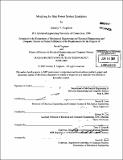Modeling for ship power system emulation
Author(s)
Leghorn, Jeremy T. (Jeremy Thomas)
DownloadFull printable version (59.41Mb)
Other Contributors
Massachusetts Institute of Technology. Dept. of Electrical Engineering and Computer Science.
Advisor
Steven B. Leeb and Robert W. Cox.
Terms of use
Metadata
Show full item recordAbstract
With the U.S. Navy's continued focus on Integrated Fight Thru Power (IFTP) there has been an ever increasing effort to ensure an electrical distribution system that maintains maximum capabilities in the event of system faults. This is to ensure that the crew has the ability to complete real time tactical missions in the event of battle damage to any localized portions of the electrical distribution system. Fault isolation is a priority component of the U.S. Navy's Next Generation Integrated Power System (NGIPS) Roadmap, which lays out the framework as well as milestone dates for future development. Non-Intrusive Load Monitoring (NILM), which has been used extensively for condition based maintenance applications, could simultaneously be used to enhance the existing zonal protection system employed with Multi-Function Monitors (MFM). NILM may be able to, inexpensively, use the existing current and voltage sensors available from the MFM hardware to determine electrical loading which could allow for faster fault isolation capability. A test platform with three 5000 watt synchronous generators is being constructed to emulate a U.S. Navy DDG 51 FLT IIA class ship electric plant. This is being accomplished in order to evaluate the feasibility of improving the fault isolation capabilities of the MFM with NILM implementation. The first step in this endeavor will be to electrically relate the test platform to the DDG electric plant. In order to accomplish this step, the fault simulation results from the test platform will be compared to simulated faults using U.S. Navy data from DDG 51 electric plants. (cont.) This will allow for the fault isolation results from the test platform to be related to the DDG 51 electric plant.
Description
Thesis (Nav. E.)--Massachusetts Institute of Technology, Dept. of Mechanical Engineering; and, (S.M.)--Massachusetts Institute of Technology, Dept. of Electrical Engineering and Computer Science, 2009. Includes bibliographical references (p. 68).
Date issued
2009Department
Massachusetts Institute of Technology. Department of Electrical Engineering and Computer Science; Massachusetts Institute of Technology. Department of Mechanical EngineeringPublisher
Massachusetts Institute of Technology
Keywords
Mechanical Engineering., Electrical Engineering and Computer Science.